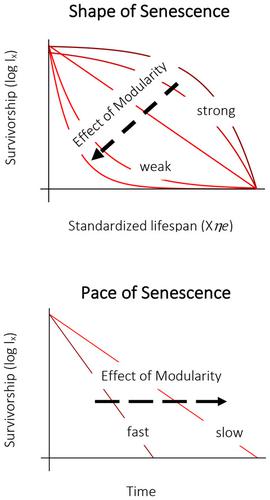当前位置:
X-MOL 学术
›
Funct. Ecol.
›
论文详情
Our official English website, www.x-mol.net, welcomes your feedback! (Note: you will need to create a separate account there.)
Testing Finch’s hypothesis: The role of organismal modularity on the escape from actuarial senescence
Functional Ecology ( IF 5.2 ) Pub Date : 2020-01-01 , DOI: 10.1111/1365-2435.13486 Connor Bernard 1 , Aldo Compagnoni 2 , Roberto Salguero‐Gómez 1, 3, 4
Functional Ecology ( IF 5.2 ) Pub Date : 2020-01-01 , DOI: 10.1111/1365-2435.13486 Connor Bernard 1 , Aldo Compagnoni 2 , Roberto Salguero‐Gómez 1, 3, 4
Affiliation

|
Until recently, senescence was assumed to be a universal phenomenon. Evolutionary theories of senescence predict that no organism may escape the physiological decline that results in an increase in mortality risk and/or decline in fertility with age. However, evidence both in animals and plants has emerged in the last decade defying such predictions. Researchers are currently seeking mechanistic explanations for the observed variation in ageing trajectories. We argue that the historical view on the inevitability of senescence is due, in part, to the development of its classical theories, which targeted primarily unitary organisms. In unitary species, the integration of resources and functions is high, and adult size is determined. In contrast, the architecture of modular organisms is indeterminate and built upon repeated modules. The isolation of mortality risk in species like hydra (Hydra spp.) or creosote brush Larrea tridentata may explain their null or even negative senescence. Caleb Finch hypothesized three decades ago that species with the ability to compartmentalize risk may escape senescence. Here, we first review the evidence on organisms that slow down or even avoid senescence in the context of their architecture, along a continuum of unitarity-modularity. Then, we use open-access databases to comparatively analyse various moments of senescence and link longevity to the degree of anatomical modularity. Our analysis compares the pace of senescence across 138 plants and 151 animals, and the shape of senescence across a subset of these. Our comparative analysis reveals that plant species that are more modular do indeed tend to escape from senescence more often than those that are unitary. The role of modularity in animal senescence is less clear. In light of novel support for Finch's hypothesis across a large diversity of plant species, and with less conclusive findings in animals, we identify new research directions. We highlight the opportunities related to age-dependent mortality factors. Other areas for further research include the role of modularity in relation to endocrine actions, and the costs of modular anatomies.
中文翻译:

检验 Finch 的假设:有机体模块化在逃避精算衰老中的作用
直到最近,衰老还被认为是一种普遍现象。衰老的进化理论预测,任何生物体都无法逃脱生理衰退,这种衰退会导致死亡风险增加和/或生育能力随着年龄的增长而下降。然而,在过去十年中,动物和植物中出现的证据与这些预测背道而驰。研究人员目前正在寻求对观察到的衰老轨迹变化的机械解释。我们认为,关于衰老不可避免的历史观点部分归因于其主要针对单一生物体的经典理论的发展。在单一物种中,资源和功能的整合度高,成虫大小确定。相比之下,模块化生物的架构是不确定的,并且建立在重复的模块之上。九头蛇 (Hydra spp.) 或杂酚油刷 Larrea tridentata 等物种死亡风险的隔离可以解释它们的无效甚至消极衰老。三年前,Caleb Finch 假设具有区分风险能力的物种可能会避免衰老。在这里,我们首先回顾了生物体在其结构的背景下减缓甚至避免衰老的证据,沿着单一性-模块化的连续体。然后,我们使用开放访问数据库来比较分析衰老的各个时刻,并将长寿与解剖模块化程度联系起来。我们的分析比较了 138 种植物和 151 种动物的衰老速度,以及其中一部分的衰老形状。我们的比较分析表明,更模块化的植物物种确实比单一的植物物种更容易摆脱衰老。模块化在动物衰老中的作用不太清楚。鉴于 Finch 的假设在大量植物物种中得到了新的支持,并且在动物中的结论性研究较少,我们确定了新的研究方向。我们强调了与年龄相关的死亡率因素相关的机会。其他需要进一步研究的领域包括模块化在内分泌作用中的作用,以及模块化解剖结构的成本。我们确定新的研究方向。我们强调了与年龄相关的死亡率因素相关的机会。其他需要进一步研究的领域包括模块化在内分泌作用中的作用,以及模块化解剖结构的成本。我们确定新的研究方向。我们强调与年龄相关的死亡率因素相关的机会。其他需要进一步研究的领域包括模块化在内分泌作用中的作用,以及模块化解剖结构的成本。
更新日期:2020-01-01
中文翻译:

检验 Finch 的假设:有机体模块化在逃避精算衰老中的作用
直到最近,衰老还被认为是一种普遍现象。衰老的进化理论预测,任何生物体都无法逃脱生理衰退,这种衰退会导致死亡风险增加和/或生育能力随着年龄的增长而下降。然而,在过去十年中,动物和植物中出现的证据与这些预测背道而驰。研究人员目前正在寻求对观察到的衰老轨迹变化的机械解释。我们认为,关于衰老不可避免的历史观点部分归因于其主要针对单一生物体的经典理论的发展。在单一物种中,资源和功能的整合度高,成虫大小确定。相比之下,模块化生物的架构是不确定的,并且建立在重复的模块之上。九头蛇 (Hydra spp.) 或杂酚油刷 Larrea tridentata 等物种死亡风险的隔离可以解释它们的无效甚至消极衰老。三年前,Caleb Finch 假设具有区分风险能力的物种可能会避免衰老。在这里,我们首先回顾了生物体在其结构的背景下减缓甚至避免衰老的证据,沿着单一性-模块化的连续体。然后,我们使用开放访问数据库来比较分析衰老的各个时刻,并将长寿与解剖模块化程度联系起来。我们的分析比较了 138 种植物和 151 种动物的衰老速度,以及其中一部分的衰老形状。我们的比较分析表明,更模块化的植物物种确实比单一的植物物种更容易摆脱衰老。模块化在动物衰老中的作用不太清楚。鉴于 Finch 的假设在大量植物物种中得到了新的支持,并且在动物中的结论性研究较少,我们确定了新的研究方向。我们强调了与年龄相关的死亡率因素相关的机会。其他需要进一步研究的领域包括模块化在内分泌作用中的作用,以及模块化解剖结构的成本。我们确定新的研究方向。我们强调了与年龄相关的死亡率因素相关的机会。其他需要进一步研究的领域包括模块化在内分泌作用中的作用,以及模块化解剖结构的成本。我们确定新的研究方向。我们强调与年龄相关的死亡率因素相关的机会。其他需要进一步研究的领域包括模块化在内分泌作用中的作用,以及模块化解剖结构的成本。



























 京公网安备 11010802027423号
京公网安备 11010802027423号